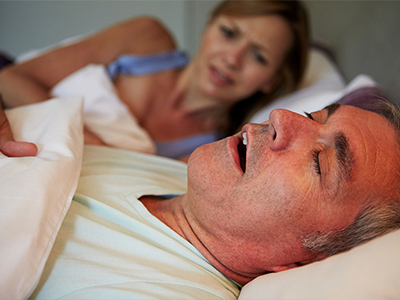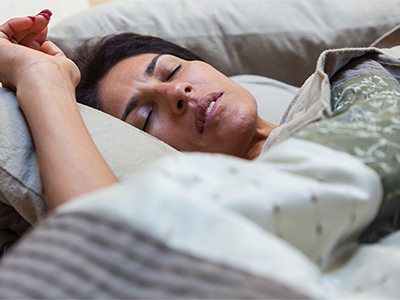If obstructive sleep apnea is not effectively managed, it can have serious consequences on your patient’s cardiovascular health in the long term. Watch this video to learn more.
Obstructive sleep apnea (OSA) and central sleep apnea (CSA) go hand in hand with health conditions that affect the respiratory, nervous, cardiovascular and endocrine systems.
If obstructive sleep apnea is not effectively managed, it can have serious consequences on your patient’s cardiovascular health in the long term. Watch this video to learn more.
People with sleep-disordered breathing (SDB) have an increased risk of developing hypertension, independent of other relevant risk factors.1-5 This risk is related to SDB severity: the more severe the SDB, the greater the risk of developing hypertension.
During healthy sleep, blood pressure decreases, but SDB patients instead tend to experience:
SDB is present in more than 30% of patients with hypertension,6 and in around 80% of patients with drug resistant hypertension.5 For this group of patients in particular, treatment with positive airway pressure therapy may be especially important.7
Up to 50% of heart failure patients experience moderate to severe sleep-disordered breathing (SDB),8 in the form of central sleep apnea (CSA), Cheyne-Stokes respiration (CSR), obstructive sleep apnea (OSA)or a combination thereof.9
Cheyne-Stokes respiration (CSR) occurs when periods of hyperventilation and hypoventilation (in a waxing/waning breathing pattern) alternate with periods of central hypopnoea/apnea. CSR is a common form of SDB in patients with severe left ventricular dysfunction.10
It’s thought that SDB and CSR accelerate the progression of heart failure by causing:
Fragmented sleep resulting from CSR also causes fatigue and daytime sleepiness, which impacts quality of life.
A large MediCare study on newly diagnosed heart failure patients has shown that those with SDB have a worse prognosis compared to those without.12Nocturnal CSA/CSR in itself is associated with increased mortality13 in congestive heart failure patients.
Learn more about the treatment options for patients with CSR.
The majority of patients who have experienced a stroke and transient ischemic attack also have SDB,14 which is sometimes undiagnosed. As stroke patients with SDB also have worse functional outcomes15, you should consider screening for SDB16 when investigating the stroke.
Stroke has the potential to cause SDB, by either affecting:
People with sleep apnea may be predisposed to stroke through a number of symptoms they experience. In particular:
Patients with both sleep apnea and stroke usually show poor compliance with post-stroke rehabilitation programs. This is mainly due to the combination of:
Recognising sleep apnea in stroke survivors is often challenging because the symptoms associated with sleep apnea are often attributed to strokes. A complete sleep history from family members can help you determine whether sleep apnea was present prior to the stroke or developed after the stroke.
Sleep apnea is common among patients with type 2 diabetes.19 It is independently associated with insulin resistance, glucose intolerance and metabolic syndrome,20-22 and when untreated, can lead to poor overall treatment outcomes.
However, despite the number of type 2 diabetes patients with SDB, it largely goes undiagnosed.
As a result of accumulated research, the International Diabetes Federation recognises the association between type 2 diabetes and sleep apnea, and recommends routinely screening OSA patients for type 2 diabetes, and screening type 2 diabetes patients displaying sleep apnea symptoms for OSA.
As patients with sleep apnea and patients with diabetes share similar comorbidities, screening both ways is recommended: check for sleep apnea in diabetes patients, and check for diabetes in patients with sleep apnea.23
Obstructive Sleep Apnea and Chronic Obstructive Pulmonary Disease (COPD) are two diseases that often coexist within a patient.
COPD is a condition that describes the progressive deterioration of the respiratory system by pulmonary airway obstruction, emphysema and decreased airflow. COPD also refers to lung disorders such as chronic bronchitis, and in some cases, chronic asthma.
According to the American Thoracic Society, patients with Chronic Obstructive Pulmonary Disease (COPD) have a higher prevalence of sleep disorders than the general population, with close to 50% of patients reporting significant disturbance in sleep quality.
Co-existence of both COPD and OSA occurs in 1% of adults.24
COPD and OSA are often coined as overlap syndrome. Both COPD and OSA are independent risk factors for the following:
Studies have shown that patients with untreated overlap syndrome have a higher mortality rate1. We at ResMed strive to impact comorbidity and improve quality of life. We offer a range of treatment options to alleviate the symptoms of COPD.
Although scientists continue to research the risks created by, and associated with, sleep apnea, patients’ sleep-disordered breathing often goes untreated. Learn how to get your patients screened for sleep apnea and how to treat them to diminish the risk of other chronic diseases


There are three types of sleep apnea: Obstructive Sleep Apnea (OSA), Central Sleep Apnea (CSA) and mixed or complex sleep apnea. Each type has distinctive characteristics that enable diagnosis.

ResMed gives you the tools to screen your patients for sleep-disordered breathing, request a sleep study, and get them diagnosed.
Peppard PE et al. N Engl J Med. 2000
Peppard PE et al. N Engl J Med. 2000
Lavie P et al. BMJ. 2000
Nieto FJ, Young TB et al. JAMA. 2000
Bixler EO, Vgontzas AN at al. Arch Intern Med. 2000
Marin JM et al. JAMA. 2012
Logan AG, Perlikowski SM et al. J Hypertens. 2001
Montesi et al. Journal of Clinical Sleep Medicine. 2012
Bitter T. et al, EJHF, 2009
Oldenburg O et al. Circ J 2012
Lanfranchi PA et al. Circulation. 2003
Garcia-Touchard A et al. Chest. 2008
Javaheri S et al. AJRCCM. 2011
Javaheri S et al. J Am Col Cardiol. 2007
Johnson KG, et al. J Clin Sleep Med. 2010
Martínez-García MA, et al. Am J Respir Crit Care Med. 2009
Wessendorf TE, et al. J Neurol. 2000
Drager LF, et al. Chest. 2011
Jelic S, et al. Trends Cardiovasc Med. 2008
Einhorn et al. Endocr Pract. 2007
Aronsohn et al. Am J Respir Crit Care Med. 2010
Punjabi et al. Am J Respir Crit Care Med. 2002
Coughlin et al. Eur Heart J. 2004
International Diabetes Federation. The IDF consensus statement on sleep apnea and type 2 diabetes. Brussels, Belgium: International Diabetes Federation; 2008
Ruth Lee, Walter T. McNicholas. Obstructive Sleep Apnea in Chronic Obstructive Pulmonary Disease Patients. Curr Opin Pulm Med. 2011;17(2):79-83.